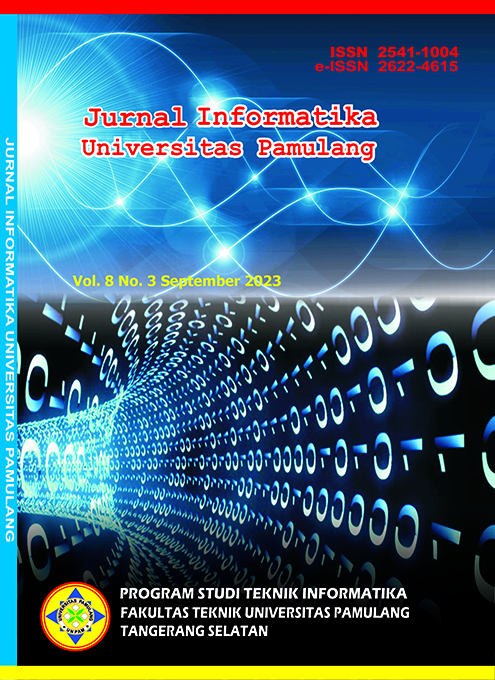Implementasi Data Mining Association Rules Menggunakan Algoritma Fp-Growth untuk Data Penjualan Keramik
DOI:
https://doi.org/10.32493/informatika.v8i3.34442Keywords:
Data Mining, Association Rules, FP-Growth, Ceramic, CV Sukses BersamaAbstract
The ceramic company CV Sukses Bersama is facing challenges in determining the optimal product layout and promotion strategy. To address this issue, this research applies the Data Mining Association Rules method using the FP-Growth algorithm. With the Python programming language, the author conducts an analysis of the company's sales data to identify significant purchasing patterns. The analysis results reveal that the product 'MCC' enjoys an exceptionally high level of popularity, with a support rate reaching 94.86%. This indicates that 'MCC' is the primary favorite among CV Sukses Bersama's customers. The analysis also unveils several significant Association Rules, such as {'MCC'} -> {'HRM'} with a confidence level of 86.99%. This implies that customers who purchase 'MCC' tend to buy 'HRM' with a high level of certainty. These findings hold strategic importance for CV Sukses Bersama, offering valuable insights that can be utilized to design more effective marketing strategies by understanding customer preferences and optimizing product stock management.References
AlindGupta. (2019). ML | Frequent Pattern Growth Algorithm. Www.Geeksforgeeks.Org. https://www.geeksforgeeks.org/ml-frequent-pattern-growth-algorithm/
Almira, A., Suendri, & Ali Ikhwan, dan. (2021). Implementasi Data Mining Menggunakan Algoritma Fp-Growth pada Analisis Pola Pencurian Daya Listrik. Jurnal Informatika Universitas Pamulang, 6(2), 442–448. http://openjournal.unpam.ac.id/index.php/informatika442
Anas, A. (2020). Penerapan Algoritma Fp-Growth Dalam Menentukan Perilaku Konsumen Ghania Mart Muara Bulian. Jurnal Ilmiah Media Sisfo, 14(2), 120–129. https://doi.org/10.33998/mediasisfo.2020.14.2.879
Ardianto, A., & Fitrianah, D. (2019). Penerapan Algoritma FP-Growth Rekomendasi Trend Penjualan ATK Pada CV. Fajar Sukses Abadi. Jurnal Telekomunikasi Dan Komputer, 9(1), 49. https://doi.org/10.22441/incomtech.v9i1.3263
Bakti. (2019). Bahasa Pemograman Python : Pengertian, Sejarah, Kelebihan dan Kekurangannya. https://www.baktikominfo.id/id/informasi/pengetahuan/bahasa_pemrograman_python_pengertian_sejarah_kelebihan_dan_kekurangannya-954
Lestari, L., & Zakiyyah, A. M. (2020). Penerapan Algoritma Fp-Growth Untuk Menganalisa Pola Pembelian Konsumen Pada Data Transaksi Penjualan Toko Delima Jaya. Universitas Muhammadiyah Jember.
Mulya, D. P. (2019). Analisa Dan Implementasi Association Rule Dengan Algoritma Fp-Growth. Teknologi Dan Sistem Informasi Bisnis, 1(1), 1–11.
Munanda, E., & Monalisa, S. (2021). Penerapan Algoritma Fp-Growth Pada Data Transaksi Penjualan Untuk Penentuan Tataletak. Jurnal Ilmiah Rekayasa Dan Manajemen Sistem Informasi, 7(2), 173–184. http://ejournal.uin-suska.ac.id/index.php/RMSI/article/view/13253
N, Arifin, R. (2015). Implementasi Algoritma Frequent Pattern Growth (FP-GROWTH) Menentukan Asosiasi Antar Produk (Study KAsus Nadia Mart). Dokumen Karya Ilmiah, 0–1.
Nursyani, U. A. (2020). Penerapan Data Mining Menggunakan Algoritma Fp – Growth Untuk Menentukan Pola Pembelian Produk Makanan - Repository UIN Sumatera Utara. Universitas Islam Negeri Sumatera Utara.
Tahir, M., & Sitompul, N. (2021). Penerapan Algoritma Fp-Growth Dalam Menentukan Kecenderungan Mahasiswa Mengambil Mata Kuliah Pilihan. Network Engineering Research Operation, 6(1), 59. https://doi.org/10.21107/nero.v6i1.216
Umnadmin. (2022). Mahasiswa Perlu Tahu, Ini Pentingnya Python untuk Berkarir di Bidang Data Science. Universitas Multimedia Nusantara. https://www.umn.ac.id/mahasiswa-perlu-tahu-ini-pentingnya-python-untuk-berkarir-di-bidang-data-science/
Utama, K. M. R. A., Umar, R., & Yudhana, A. (2020). Penerapan Algoritma Fp-Growth Untuk Penentuan Pola Pembelian Transaksi Penjualan Pada Toko Kgs Rizky Motor. Dinamik, 25(1), 20–28. https://doi.org/10.35315/dinamik.v25i1.7870
Yulianton, H. (2014). Data Mining untuk Dunia Bisnis. Teknologi Informasi DINAMIK, XIII(1), 9–15.
Downloads
Published
Issue
Section
License
Copyright (c) 2023 Muhammad Isra Almahsa, Alwis Nazir, Iis Afriyanti, Elvia Budianita

This work is licensed under a Creative Commons Attribution-NonCommercial 4.0 International License.
Authors who publish with this journal agree to the following terms:
- Authors retain copyright and grant the journal right of first publication with the work simultaneously licensed under a Creative Commons Attribution-NonCommercial 4.0 International (CC BY-NC 4.0) that allows others to share the work with an acknowledgement of the work's authorship and initial publication in this journal.
- Authors are able to enter into separate, additional contractual arrangements for the non-exclusive distribution of the journal's published version of the work (e.g., post it to an institutional repository or publish it in a book), with an acknowledgement of its initial publication in this journal.
- Authors are permitted and encouraged to post their work online (e.g., in institutional repositories or on their website) prior to and during the submission process, as it can lead to productive exchanges, as well as earlier and greater citation of published work (See The Effect of Open Access).
Jurnal Informatika Universitas Pamulang have CC-BY-NC or an equivalent license as the optimal license for the publication, distribution, use, and reuse of scholarly work.
In developing strategy and setting priorities, Jurnal Informatika Universitas Pamulang recognize that free access is better than priced access, libre access is better than free access, and libre under CC-BY-NC or the equivalent is better than libre under more restrictive open licenses. We should achieve what we can when we can. We should not delay achieving free in order to achieve libre, and we should not stop with free when we can achieve libre.
Jurnal Informatika Universitas Pamulang is licensed under a Creative Commons Attribution-NonCommercial 4.0 International (CC BY-NC 4.0)
YOU ARE FREE TO:
- Share : copy and redistribute the material in any medium or format
- Adapt : remix, transform, and build upon the material for any purpose, even commercially.
- The licensor cannot revoke these freedoms as long as you follow the license terms





